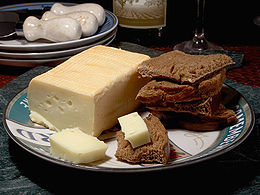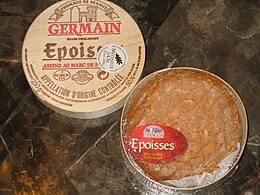All
cheese starts off basically in the same manner, with curds and whey. It’s a
process as old as the centuries. But what makes some cheese so stinky as to be
banned from public transportation?
The
two main factors that provide cheese its aroma are aging, also known as
ripening, and washing. The longer the cheese ages, the stronger the odour.
Washing is another method that intensifies the aroma; common washes include
rum, beer and salt water. The combination of aging and washing, is therefore,
what can produce some intense pong.
But
does strong odour affect the taste of the cheese?
“I
always like to say with cheese, its bark is bigger than its bite, meaning the
smell is stronger than the taste,” says Afrim Pristine, owner off
Cheese Boutique in Toronto.
With
that in mind, grab your nose plugs, a baguette, your favourite wine or beer,
and give these cheeses from around the globe a try.
Limburger, Belgium and Germany
 |
| photo courtesy of wikipedia.org |
Originally
created in the Duchy of Limburg, this cheese ages in the bacteria Brevibacterium linens, which, by the way, is
the same bacteria found in body and foot odour. Limburger cheese ages for three
months at which time is becomes spreadable. The most traditional way to eat
Limburger cheese is to spread it on a fairly solid bread such as rye, top it
with a slice of onion and wash it all down with a beer.
Epoisses de Bourgogne, France
 |
| photo courtesy of wikipedia.org |
Said
to be a favourite of Napoleon’s, Epoisses de Bourgogne has been made in central
France since the 1700s. The odour from this cheese is so strong that it has
reportedly been banned from France’s public transportation system. During its
six week aging process, the cheese is washed with a mixture of water and Marc de Bourgogne brandy. The brandy is what gives the cheese its
delicate flavour and the primary source of the cheese’s strong stench. To best
enjoy this cheese, pair it with acidic fruits such as pears, apples and figs.
Nuts and a good wine are also good picks.
Also
known as Sablé du Boulonnais, this soft yet firm cheese is an
unpasteurized cows’ milk cheese with a red-orange washed rind. It ages anywhere
from seven to nine weeks and is washed in beer. It was rated as the world’s
stinkiest some years back,
but despite its odourous smell, Vieux Boulogne does not have a sharp taste.
Rather it is mild and rich and best enjoyed with a good quality beer or even
Champagne. It’s French, after all, so why not?
The
name of this cheese says it all. This is a cows’ milk cheese made in
Gloucestershire, in the southwest of England, since 1972. This cheese ages up
to two months, during which time it is immersed every few weeks in perry made of local Stinking Bishop pears, giving the cheese its distinct pungent
odour. A pear-flavoured liqueur works well as a drink option with this cheese,
as does a good local beer.
Palpusztai, Hungary
 |
| photo courtesy of wikipedia.org |
This
cheese is also created by the bacterium Brevibacterium linens. First made in
Hungary in the 1890s, Palpusztai is a soft cows’ milk cheese, runny and
outright stinky. Because of its high ammonia content, it has been known to
bring tears to the eyes. But fear not. Get over the heady smell, grab a good,
strong ale and do like the locals.
Enjoy!
Enjoy!



No comments:
Post a Comment